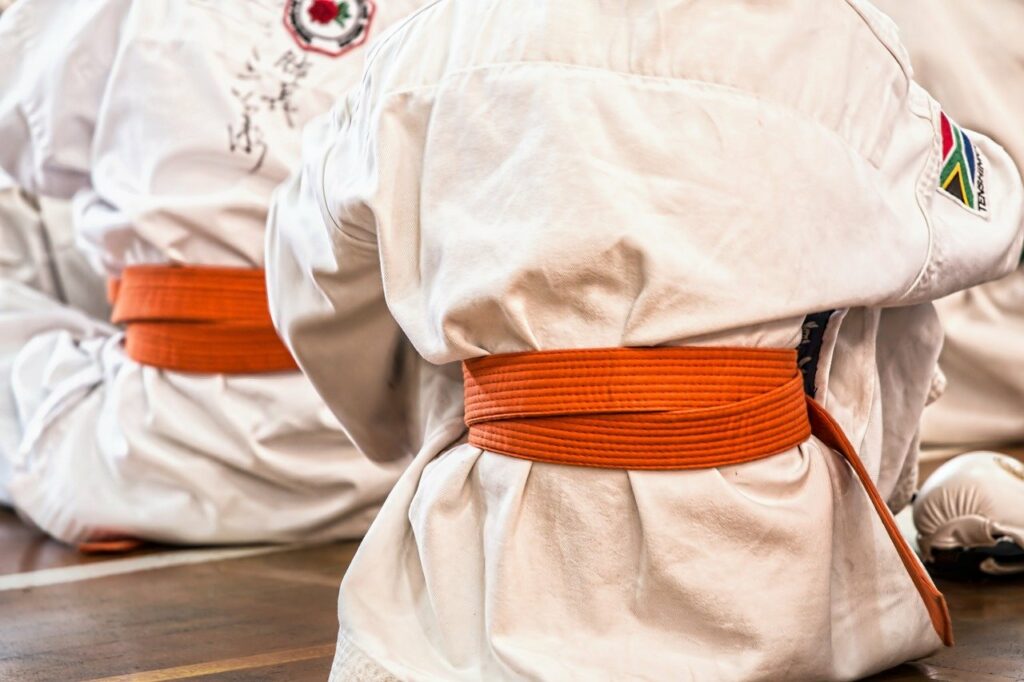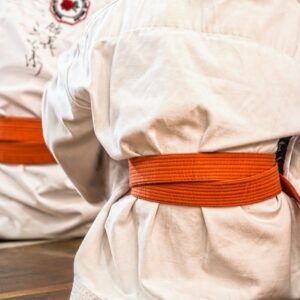No today it is not about historical background or the historical origin of the karate suit. Also the belt is not in the foreground here. I have already dealt with them in detail at this point.
This time it is only about the Gi itself.
Correct would be Keikogi (稽古着; suit for training), but in the West we have abbreviated the word to Karate-Gi or Gi for short. The important thing is not the word, but that we all know what is meant.
What are the different products on the market ?
What do the many technical terms of the manufacturers actually mean?
And what comes in the end for me into question ?
Freely according to the motto:
„Show me your Gi, and I tell you what kind of Karate you do“.

The purchase of a Gi is a science in itself. The longer you occupy yourself with it, the more several things become clear to you. First:
The choice is huge. Second: The differences are sometimes considerable. Third: Apparently everyone has a different opinion about what is the ultimate in training clothes.
From the latter, it is clear that the Gi is a very personal matter. Because ideally it should be like a second skin. I therefore advise every karateka not to leave the choice to chance or simply to join the majority. Even advanced karateka, who have been „shooting“ at a model for many years, should at least try on another Gi. In fact, a lot has happened in the last ten or twelve years. To read here: https://www.borkenerzeitung.de/lokales/borken/Beim-Karate-werden-neben-Selbstverteidigung-auch-Werte-vermittelt-310307.html
First of all, at the beginning of your election you are unfortunately still frequently asked:
„Should it be a suit for Kumite or for Kata ?
This classification is stupid stuff; to put it bluntly. Later we will see in detail why. By the way, the same division is imposed on children’s clothing again and again. Here the question is usually: „Pink or blue? This stencil-like thinking makes no sense and is therefore completely superfluous. Buy a karate suit that you feel comfortable in and that fits your karate. It should simply always fit comfortably.
Now that we have eliminated the biggest mistake, we still have to remove some minor obstacles. Because the way to your perfect Gi is not only blocked by outdated stencil thinking, but also littered with – technical jargon.
As a matter of course, innumerable providers on their websites throw around technical terms from the beautiful world of textile finishing. In addition still various own creations and special stored special cases come. But one after the other.
Meanwhile one reads in most descriptions the designation Canvas cotton. Cotton itself is the main material of every karate suit. Either one hundred percent or with the addition of synthetic components; so-called mixed fabric. In rare cases, a Gi can also be made of synthetic fiber only (fully synthetic).
Canvas cotton is simply canvas; also called linen. As the name suggests, this type of cotton was formerly used in shipping and painting (canvas).
It is a firm and therefore rather stiff fabric, whereby front and back are identical. photo of cotton
Cotton has the advantage that it does not lie close to the skin when wet (i.e. when sweating) and as a natural material is comfortable to wear. Cotton warms in winter and cools in the warm months. It easily absorbs sweat and is resistant even when wet. Cotton is hard-wearing and particularly skin-friendly. Anyone who has ever worn and washed a cotton shirt for several years knows that it is permanently dimensionally stable, can be washed even at high temperatures and is therefore very hygienic. But it is not only very durable, it is also tear-resistant and crease-resistant. If it does crease, wrinkles can be ironed out with high temperature.
However, karate suits are not ironed. It is enough to take them off after washing. So pull them mechanically, by hand, and beat them smooth.
With karate suits, „strength“ or weight plays a major role.
The fabric weight is the weight per square meter of a karate suit and is usually given in ounces (oz) per square yard. The higher this weight per square yard, the heavier the gi.
1 square yard = 8361.2736 cm²
Please note that the fabric weight is not the same as the fabric thickness. This again depends on the cotton quality, yarn thickness, material composition and weaving technique.
Usually you can buy a Gi in five different „thicknesses“.
Karate Gi 8 oz (272 g/m²)
Karate Gi 10 oz (340 g/m²)
Karate Gi 12 oz (408 g/m²)
Karate Gi 14 oz (476 g/m²)
Karate Gi 16 oz (544 g/m²)
Karate suits with a higher fabric weight therefore also have a longer life span.
The moreover one reads in descriptions of many offerers something of:
Cotton brushed.
Brushing out cotton makes fabrics denser and removes unattractive lint, and also makes the fabric a little softer.
As already mentioned a Gi can also be fully synthetic; instead of 100% cotton.
Polyester was invented in the 1930s as a substitute for silk. The synthetic fabric is available in various finishes such as microfibre or fleece.
Polyester is particularly hard wearing and very easy to clean. Polyester fabric dries quickly and does not need to be ironed on a low level or only very rarely. The synthetic fiber can be produced at low cost and thus allows for inexpensive raw materials.
It is light, all ding potentially irritating to the skin.
Cotton and polyester are often blended because the positive properties of the two materials combine. For example, cotton absorbs moisture particularly well, but does not release it as well. Polyester is the exact opposite. A mixture of the two materials means that a Gi absorbs moisture particularly well and also releases it again, for example when you sweat or after washing.
Other materials such as lycra or elastane give the material a stretch content, which is often between 3 and 10 percent.
Another nice example of technical jargon also appears more often: Sanforised.
This is a mechanical finishing process, also known as shrinking, in which no chemicals are used. In this process, the cloth is subjected to mechanical compression before being cut to size and shrinks. The shrunk state is fixed and prevents the finished textile products from shrinking.
The English name preshrink is also included.
Here the fabric is simply pre-washed, which of course also shrinks it a bit.
Snap-effect or occasionally also sound-reinforced:
Yes, that really does exist and indeed leads to amazing results. The secret lies solely in the cut. The motto is: „War is hell, but the sound is awesome. And I am the DJ“.
High Waist always appears in connection with pants. While the waistband is usually positioned just above the hips, the High Waist is pulled up to the waist, approximately at the height of the navel. Who likes it…
Let us now come to the special cases.
Velkro openingPhoto of the velkro opening
The opening described here is located inside the karate pants, above the thigh near the genitals. The „velcro“ is hardly visible but very practical for long lasting tournaments or examinations. Do men have to take off the whole gi every now and then if they want to go fast ?
Revoflex
What the Kata lover his snap effect is to the Kumite man his light Gi, which should not stick to the body please. Full-synthetic alone is not enough with so much movement of course. There it needs extra air holes in the crotch and under the arms. In addition, the technical marvels have honeycombs or are perforated with tiny holes in the shoulder area and the extremities. Not beautiful, but rare.
Now that we know so much about materials and technical terms, let’s move on to the applications.
In the course of time it has become common to provide karate suits with coats of arms and name signs, which show the affiliation to dojo, or in international comparisons, also to nation states. Such distinguishing signs are applied to the front of the suits. This is reasonable and justifiable. During a training course, one would like to know where the training partner actually comes from. photo of the Dojo logo
The association logo always belongs on the left side. So the heart side. At international tournaments the national flag takes its place.
What can be obligatory at competitions is a nice gesture of belonging and almost always a topic of conversation at seminars, presentations and training courses. If you like your dojo, feel comfortable there and can identify with your sport comrades, you should at least have a Gi with your own dojo logo. But wear it with pride and remember that outsiders will always associate your behavior and karate with your dojo.
Sometimes you can see patches of the respective bandage on your chest. JKA, DKV, SKVD, DTKV, SKID, GKD, AKS or IKOK. Just to name a few. However, this is less common.
More rarely the style is embroidered on the suit. In my opinion this is only common for representatives of Kyokushinkai.
Of course there are still a lot of applications that appear on arms, legs or even the belt. They are all more or less related to the own style. As a logo or kanji there are sometimes colorful, sometimes less colorful primarily animals to be seen.
Tigers, cranes, dragons a cobra.
Occasionally I have even seen functions and titles. A Sensei or Instructor for example.
Unfortunately, more and more the company logo is placed extremely conspicuously on the chest or neck. While the entrance gate of a castle on Okinawa of a well known manufacturer or a falcon of a brand that is more known for Brazilian Jiu-Jitsu is still acceptable, three stripes or a naked fist can be out of place.
These unwanted applications are not only annoying, but also extremely unattractive. One should always make sure to choose a variation of the manufacturer without this defacement. Even if this usually costs a few cents
